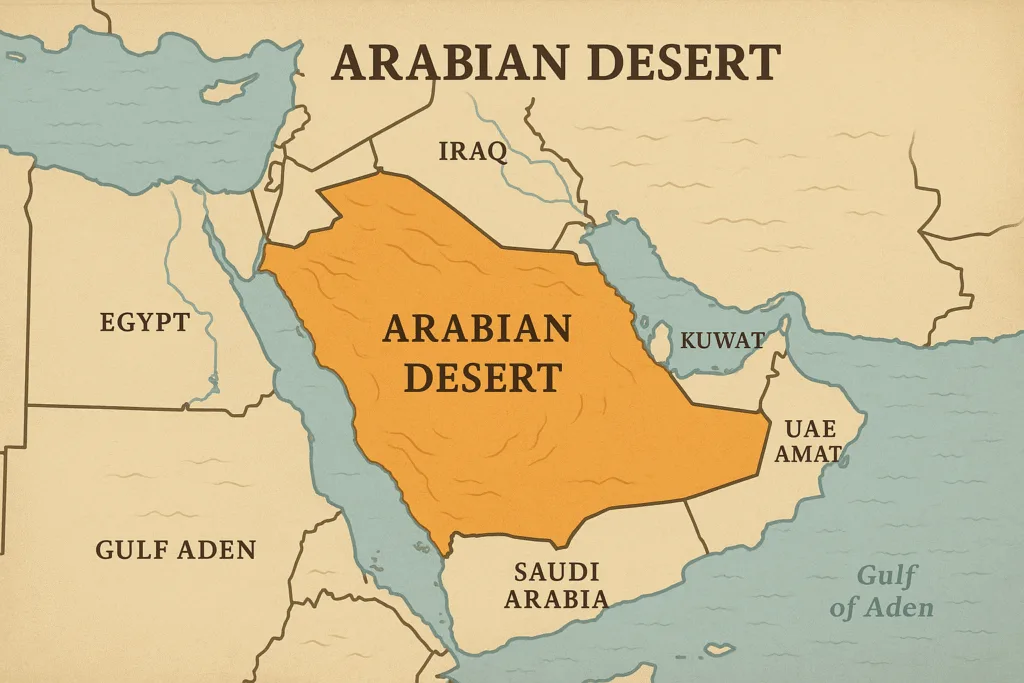Location & Continent
Continent: Asia
Countries: Afghanistan
Coordinates: 30°N, 63°E
Physical Features
Area: Approximately 150,000 km²
Length: About 650 km
Width: Roughly 150–250 km
Elevation: Around 500–900 m above sea level
Climate & Precipitation
Temperature: Extremely hot in summer (up to 45°C), cold in winter (down to −20°C)
Precipitation: Very low—usually less than 100 mm per year, with long dry seasons
Ecological Features
Ecozone: Cold desert and semi-arid plateau
Biome: Desert and dry steppe
Ecoregions: Registan–North Pakistan Sandy Desert, Sistan Basin Desert
Flora & Fauna
Flora: Sparse desert shrubs, tamarisks, and salt-tolerant grasses
Fauna: Wild goats, gazelles, foxes, hares, and desert reptiles; most species adapted to extreme aridity
Geology & Notable Features
Geology: Mostly composed of wind-blown sand, gravel plains, and clay flats; part of the larger Sistan Basin system
Notable Features: Borders the Registan Desert to the north and the Helmand River to the west; known for its shifting dunes and desolate landscapes
Introduction
Dasht-e-Margo, known as the Desert of Death, is a remote and arid desert located in southeastern Afghanistan. It is famed for its extreme temperatures, unique geographic features, and cultural significance. This article presents a comparative exploration of Dasht-e-Margo, highlighting its geography, climate, biodiversity, and cultural relevance.
Geography
Dasht-e-Margo spans over 100,000 square kilometers of rugged landscapes. The desert is surrounded by the Hormuzgan province to the north and the Sistan and Baluchestan province to the south. It is characterized by:
- Sand Dunes: Towering dunes reach heights of up to 100 meters.
- Salt Flats: Extensive salt flats often emerge following rain periods.
- Rock Formations: Unique geologic structures dot the landscape, providing clues to the desert’s geological history.
Climate
Dasht-e-Margo experiences a severe desert climate:
- Temperature: Daytime temperatures can soar to 56°C during summer.
- Precipitation: The annual rainfall is typically less than 50 mm, contributing to its arid nature.
- Wind Patterns: Strong winds shape the sand dunes and contribute to the harsh living conditions.
Biodiversity
Despite its harsh conditions, Dasht-e-Margo supports a variety of flora and fauna adapted to survive in extreme environments:
- Vegetation: Sparse vegetation includes drought-resistant shrubs and small trees like Acacia and Ephedra.
- Wildlife: Key species include:
| Wildlife | Description |
|---|---|
| Persian Gazelle | A graceful artiodactyl known for its speed and adaptability. |
| Sand Gecko | A small reptile that thrives in sandy habitats. |
| Various Rodents | Nimble creatures that can subsist on minimal water. |
Human Settlement and Culture
While Dasht-e-Margo is largely inhospitable, nomadic tribes such as the Baluch inhabit its edges. These communities are renowned for their traditional lifestyles and unique cultural practices, including:
- Craftsmanship: They create intricate handicrafts, reflecting the desert’s aesthetic.
- Traditional Music: Folk songs often depict the beauty and challenges of desert life.
- Festivals: Annual events celebrate the cultural heritage while promoting the bonding of communities.
Tourism and Exploration
Although challenging, Dasht-e-Margo attracts adventure seekers and researchers interested in desert ecosystems:
- Photography: The stunning dunes and unique rock formations provide magnificent photo opportunities.
- Scientific Research: Scientists study the desert’s ecology, climate, and geology.
- Adventure Tours: Guided tours enable visitors to experience the desert’s grandeur under expert supervision.
Conclusion
Dasht-e-Margo stands out not only as a geographical wonder but also as a testament to nature’s resilience. Its dramatic terrains and rich biodiversity showcase a unique part of Earth’s ecology. For enthusiasts hoping to explore this captivating desert, proper planning and respect for local cultures are essential.
References & Sources
- National Geographic Society. (2023). Dasht-e Margo (Desert of Death). Retrieved from
https://education.nationalgeographic.org/resource/dasht-e-margo - United States Geological Survey (USGS). (2022). Afghanistan Geology and Terrain Mapping: Southwestern Deserts Region. Retrieved from
https://www.usgs.gov/centers/afghanistan - NASA Earth Observatory. (2021). Sand and Dust Activity in the Dasht-e Margo and Registan Deserts. Retrieved from
https://earthobservatory.nasa.gov/ - University of Nebraska–Lincoln, Center for Advanced Land Management Information Technologies (CALMIT). (2020). Remote Sensing of Arid Landscapes: The Dasht-e Margo Basin. Retrieved from
https://calmit.unl.edu/ - Afghanistan National Environmental Protection Agency (NEPA). (2019). Climate and Desertification Report of Southern Afghanistan. Retrieved from
https://nepa.gov.af/ - United Nations Environment Programme (UNEP). (2018). Desertification in Southwest Asia: Case Studies from Afghanistan. Retrieved from
https://www.unep.org/


